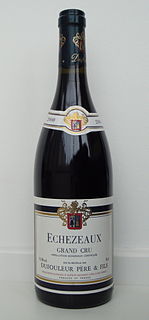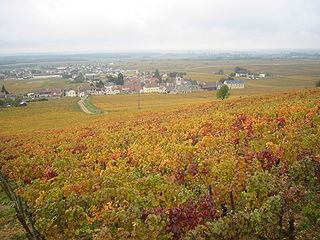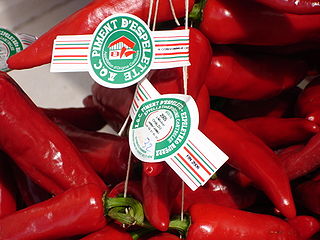
Bonnes Mares is an Appellation d'origine contrôlée (AOC) and Grand Cru vineyard for red wine in the Côte de Nuits subregion of Burgundy, with Pinot noir as the main grape variety. The AOC was created in 1936. It is shared between the two communes of Chambolle-Musigny and Morey-Saint-Denis in the Côte-d'Or département. Bonnes Mares is located a little to the north of the Chambolle-Musigny village, and borders the Route des Grands Crus in the east and the Grand Cru vineyard Clos de Tart in the north.

Corton is an Appellation d'origine contrôlée (AOC) and Grand Cru vineyard for red and white wine in Côte de Beaune subregion of Burgundy. It is located on a hill shared between the three villages of Aloxe-Corton, Pernand-Vergelesses and Ladoix in the Côte de Beaune, Burgundy. The appellation covers the lower parts of the Corton hill and includes several subordinate vineyard names, or climats, within the AOC. Because of the size of the AOC and the variability of these climats, it is the rule rather than the exception that the name of the climat is indicated together with that of the Corton AOC, leading to designations such as Corton Clos du Roi and Corton Les Bressandes. Corton is rare in this aspect, as the 'climat' is seldom used for other Grand Cru appellations in Côte d'Or. The AOC was created in 1937.

Romanée-Saint-Vivant is an Appellation d'origine contrôlée (AOC) and Grand Cru vineyard for red wine in the Côte de Nuits subregion of Burgundy, with Pinot noir as the main grape variety. It is situated within the commune of Vosne-Romanée. La Romanée borders on La Grande Rue in the south, Romanée-Conti and Richebourg in the west, Vosne-Romanée Premier Cru vineyards in the north and in the east and also the village Vosne-Romanée itself in the east. The AOC was created in 1936. It takes its name from the Abbey of Saint Vivant, which in Medieval times owned several vineyards among the Vosne-Romanée Grands Crus.

Échezeaux is an Appellation d'origine contrôlée (AOC) and Grand Cru vineyard for red wine in the Côte de Nuits subregion of Burgundy, with Pinot noir as the main grape variety. Échezeaux is located within the commune of Flagey-Echézeaux, on a strip of land between the territory of the communes Vosne-Romanée, Vougeot and Chambolle-Musigny. Échezeaux borders on the Clos de Vougeot and its wall as well as Grands Échezeaux in the east, on Chambolle-Musigny vineyards in the north, some Vosne-Romanée vineyards in the west and on the Vosne-Romanée Premier Cru vineyard Les Suchots in the south. The AOC was created in 1937.

Richebourg is an Appellation d'origine contrôlée (AOC) and Grand Cru vineyard for red wine in the Côte de Nuits subregion of Burgundy, with Pinot noir as the main grape variety. It is situated within the commune of Vosne-Romanée, and borders La Romanée and Romanée-Conti in the south, Romanée-Saint-Vivant in the east and Vosne-Romanée Premier Cru vineyards in the north and west. The AOC was created in 1936.
Chapelle-Chambertin is an Appellation d'origine contrôlée (AOC) and Grand Cru vineyard for red wine in the Côte de Nuits subregion of Burgundy, with Pinot noir as the main grape variety. It is located in the southern part of the commune of Gevrey-Chambertin and on the lower hillside east of Chambertin-Clos de Bèze and north of Griotte-Chambertin. The AOC was created in 1937.
Mazis-Chambertin, sometimes written Mazy-Chambertin is an Appellation d'origine contrôlée (AOC) and Grand Cru vineyard for red wine in the Côte de Nuits subregion of Burgundy, with Pinot noir as the main grape variety. Mazis-Chambertin is located within the commune of Gevrey-Chambertin. It is situated above the Route des Grands Crus. It borders on Chambertin-Clos de Bèze in the south, Ruchottes-Chambertin in the west, and on Gevrey-Chambertin Premier Cru vineyards in the north and east. Among the various "Chambertin" vineyards, it is the one situated closer to the town of Gevrey-Chambertin itself. The AOC was created in 1937, and should not be confused with the entirely separate Mazoyères-Chambertin.
Ruchottes-Chambertin is an Appellation d'origine contrôlée (AOC) and Grand Cru vineyard for red wine in the Côte de Nuits subregion of Burgundy, with Pinot noir as the main grape variety. Ruchottes-Chambertin is located within the commune of Gevrey-Chambertin. It is situated high up on the Côte d'Or slope, above Mazis-Chambertin, and also borders on Gevrey-Chambertin Premier Cru vineyards in the north and south. The AOC was created in 1937.

Clos des Lambrays is an Appellation d'origine contrôlée (AOC) and Grand Cru vineyard for red wine in the Côte de Nuits subregion of Burgundy, with Pinot noir as the main grape variety. It is situated in the commune of Morey-Saint-Denis in the Côte-d'Or département, and is located immediately to the southwest of the village Morey-Saint-Denis. The Clos part of its name refers to a wall-enclosed vineyard. Clos des Lambrays was elevated from premier cru to grand cru status in 1981, which meant that it was created as a separate AOC.

Clos de Tart is an Appellation d'origine contrôlée (AOC) and Grand Cru vineyard for red wine in the Côte de Nuits subregion of Burgundy, with Pinot noir as the main grape variety. It is situated in the commune of Morey-Saint-Denis in the Côte-d'Or département. Clos de Tart is located in the southern part of the commune, starts immediately west (uphill) of the village itself, and borders to the Grand Cru vineyard Bonnes Mares in the south and Clos des Lambrays in the north. The AOC was created in 1939, and the Clos part of its name refers to a wall-enclosed vineyard.

Clos Saint-Denis is an Appellation d'origine contrôlée (AOC) and Grand Cru vineyard for red wine in the Côte de Nuits subregion of Burgundy, with Pinot noir as the main grape variety. It is situated in the commune of Morey-Saint-Denis in the Côte-d'Or département. Clos de la Roche is located just to the north of the village Morey-Saint-Denis and borders to the Grand Cru vineyard Clos de la Roche in the north. The AOC was created in 1936, and the Clos part of its name refers to a wall-enclosed vineyard.
Musigny, sometimes referred to as Le Musigny, is an Appellation d'origine contrôlée (AOC) and Grand Cru vineyard for red and white wine in Côte de Nuits of Burgundy. It is located within the commune of Chambolle-Musigny, to the south of the village itself. It borders on the Grand Cru Clos de Vougeot in the southeast, to Échezeaux in the south, and to the Premier Cru Les Amoureuses in the northeast. The name is derived from a family de Musigny which is now extinct, but which held offices in the court of the Dukes of Burgundy from the 14th century. The AOC was created in 1936, but the borders of Musigny were previously set down legally in 1929.

Grands Échezeaux is an Appellation d'origine contrôlée (AOC) and Grand Cru vineyard for red wine in the Côte de Nuits subregion of Burgundy, with Pinot noir as the main grape variety. Grands Échezeaux is located within the commune of Flagey-Echézeaux, on a strip of land between the territory of the communes Vosne-Romanée, Vougeot and Chambolle-Musigny. Grands Échezeaux borders on Clos de Vougeot and its wall in the east and north, and on Échezeaux in the west and south. The AOC was created in 1936.
Mazoyères-Chambertin is an Appellation d'origine contrôlée (AOC) and Grand Cru vineyard for red wine in the Côte de Nuits subregion of Burgundy, with Pinot noir as the main grape variety. Mazoyères-Chambertin is located within the commune of Gevrey-Chambertin. It is situated below the Route des Grands Crus. It borders on Latricières-Chambertin and the Gevrey-Chambertin Premier Cru aux Combottes in the west, Charmes-Chambertin in the north, Gevrey-Chambertin village level vineyards in the east, and Morey-Saint-Denis Premier Cru vineyards in the south. The AOC was created in 1937.

La Tâche is an Appellation d'origine contrôlée (AOC) and Grand Cru vineyard for red wine in the Côte de Nuits subregion of Burgundy, with Pinot noir as the main grape variety. It is situated within the commune of Vosne-Romanée and is a monopole of the winery Domaine de la Romanée-Conti. La Tâche borders on La Grande Rue in the north, and mostly on Vosne-Romanée Premier Cru vineyards in the east, south and west. The AOC was created in 1936.
Vougeot wine is produced in the French village of Vougeot in Côte de Nuits of Burgundy. The Appellation d'origine contrôlée (AOC) Vougeot may be used for red and white wine with respectively Pinot noir and Chardonnay as the main grape variety. A characteristic of Vougeot is that most of the commune's vineyard surface is taken up by its single Grand Cru vineyard, Clos de Vougeot, which at 49.86 hectares is the largest Grand Cru of Côte de Nuits. Of the rest, most is classified as Premier Cru, leaving village-level Vougeot wine a rare occurrence, mostly restricted to a small area of flat land immediately to the east of the N74 road, but inside the commune.

Maranges wine is produced in the communes of Cheilly-lès-Maranges, Dezize-lès-Maranges and Sampigny-lès-Maranges in Côte de Beaune of Burgundy. The Appellation d'origine contrôlée (AOC) Maranges may be used for red and white wine with respectively Pinot noir and Chardonnay as the main grape variety. The production consists of around 95% red wine and 5% white wine. There are no Grand Cru vineyards within the Maranges AOC.

Morey-Saint-Denis wine is produced in the commune of Morey-Saint-Denis in the Côte de Nuits subregion of Burgundy. The Appellation d'origine contrôlée (AOC) Morey-Saint-Denis may be used for red and white wine with respectively Pinot noir and Chardonnay as the main grape variety. The production of red wine dominates greatly, with around 96 per cent, and only around four per cent white wine. There are five Grand Cru vineyards with the commune: Clos de Tart, Clos des Lambrays, Clos Saint-Denis, Clos de la Roche and Bonnes Mares, which is shared with Chambolle-Musigny.

Gevrey-Chambertin wine is produced in the communes of Gevrey-Chambertin and Brochon in the Côte de Nuits subregion of Burgundy. The Appellation d'origine contrôlée (AOC) Gevrey-Chambertin may be used only for red wine with Pinot noir as the main grape variety. There are nine Grand Cru vineyards within the commune of Gevrey-Chambertin, Chambertin and eight others called Chambertin in combination with something else, such as Chapelle-Chambertin. While Gevrey-Chambertin also has several highly regarded Premier Cru vineyards, it has a particularly large amount of vineyards at the village level for a Côte de Nuits appellation. This is because the vineyards of the AOC stretch further to the east than in most neighbouring AOCs.

Fixin wine is produced in the communes of Fixin and Brochon in the Côte de Nuits subregion of Burgundy. The Appellation d'origine contrôlée (AOC) Fixin may be used for red and white wine with respectively Pinot noir and Chardonnay as the main grape variety. The production of red wine dominates greatly, with around 96 per cent, and only around four per cent white wine. There are no Grand Cru vineyards with these communes.





















